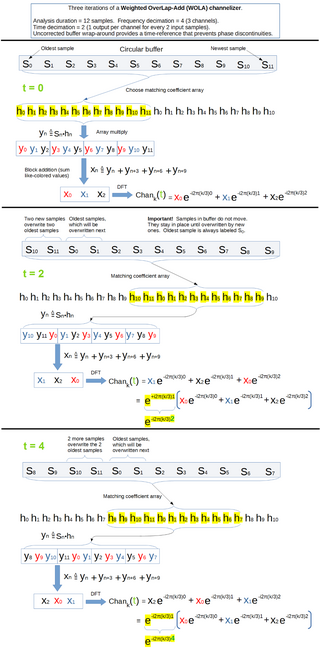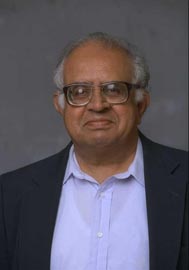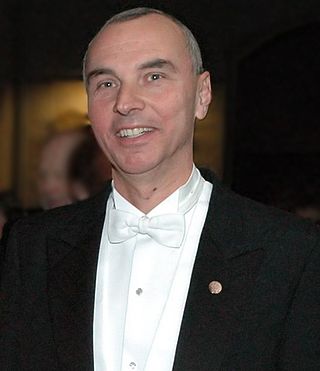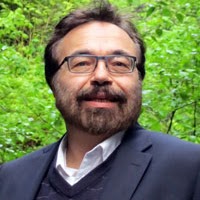Related Research Articles
Lawrence R. Rabiner is an electrical engineer working in the fields of digital signal processing and speech processing; in particular in digital signal processing for automatic speech recognition. He has worked on systems for AT&T Corporation for speech recognition.

Beamforming or spatial filtering is a signal processing technique used in sensor arrays for directional signal transmission or reception. This is achieved by combining elements in an antenna array in such a way that signals at particular angles experience constructive interference while others experience destructive interference. Beamforming can be used at both the transmitting and receiving ends in order to achieve spatial selectivity. The improvement compared with omnidirectional reception/transmission is known as the directivity of the array.

In signal processing, a filter bank is an array of bandpass filters that separates the input signal into multiple components, each one carrying a sub-band of the original signal. One application of a filter bank is a graphic equalizer, which can attenuate the components differently and recombine them into a modified version of the original signal. The process of decomposition performed by the filter bank is called analysis ; the output of analysis is referred to as a subband signal with as many subbands as there are filters in the filter bank. The reconstruction process is called synthesis, meaning reconstitution of a complete signal resulting from the filtering process.
PAST is a large-scale, distributed, persistent storage system based on the Pastry peer-to-peer overlay network.
In mathematics and statistical analysis, bicoherence is a squared normalised version of the bispectrum. The bicoherence takes values bounded between 0 and 1, which make it a convenient measure for quantifying the extent of phase coupling in a signal. The prefix bi- in bispectrum and bicoherence refers not to two time series xt, yt but rather to two frequencies of a single signal.
Precoding is a generalization of beamforming to support multi-stream transmission in multi-antenna wireless communications. In conventional single-stream beamforming, the same signal is emitted from each of the transmit antennas with appropriate weighting such that the signal power is maximized at the receiver output. When the receiver has multiple antennas, single-stream beamforming cannot simultaneously maximize the signal level at all of the receive antennas. In order to maximize the throughput in multiple receive antenna systems, multi-stream transmission is generally required.
Multi-user MIMO (MU-MIMO) is a set of multiple-input and multiple-output (MIMO) technologies for multipath wireless communication, in which multiple users or terminals, each radioing over one or more antennas, communicate with one another. In contrast, single-user MIMO (SU-MIMO) involves a single multi-antenna-equipped user or terminal communicating with precisely one other similarly equipped node. Analogous to how OFDMA adds multiple-access capability to OFDM in the cellular-communications realm, MU-MIMO adds multiple-user capability to MIMO in the wireless realm.
Ali Naci Akansu is a Turkish-American professor of electrical & computer engineering and scientist in applied mathematics.

Rangasami Lakshminarayan Kashyap was an Indian applied mathematician and a Professor of Electrical Engineering at Purdue University.

James Won-Ki Hong is Director of Innovation Center for Education, Co-Director of Center for Crypto Blockchain Research, and Professor of Dept. of Computer Science and Engineering at POSTECH. He served as Dean of Graduate of Information Technology at POSTECH from 2015 to 2019. He was Senior Executive Vice President and CTO of KT Corporation leading R&D activities from March 2012 to Feb. 2014. He received a Ph.D. degree from the University of Waterloo in 1991. His research interests include blockchain, network management, network monitoring and network analysis, ICT convergence, ubiquitous computing, and smartphonomics. He has served as Chair (2005–2009) of the IEEE Communications Society, Committee on Network Operations and Management. He has also served IEEE ComSoc Director of Online Content. He is Editor-in-Chief of International Journal on Network Management (IJNM) and of ComSoc Technology News. He is the Chair of Steering Committee of IEEE IFIP NOMS International Symposium on Integrated Network Management and Steering Committee member of APNOMS. He was General Chair of APNOMS 2006, and General Co-Chair of APNOMS 2008 and APNOMS 2011. He was General Co-Chair of IEEE/IFIP NOMS 2010. He is an editorial board member of Transactions on Network and Service Management, Journal of Network and Systems Management and Journal of Communications and Networks.

Ronald Robert Yager is an American researcher in computational intelligence, decision making under uncertainty and fuzzy logic. He is currently Director of the Machine Intelligence Institute and Professor of Information Systems at Iona College.

Peter (Petre) Stoica is a researcher and educator in the field of signal processing and its applications to radar/sonar, communications and bio-medicine. He is a professor of Signals and Systems Modeling at Uppsala University in Sweden, and a Member of the Royal Swedish Academy of Engineering Sciences, the United States National Academy of Engineering, the Romanian Academy, the European Academy of Sciences, and the Royal Society of Sciences in Uppsala. He is also a Fellow of IEEE, EURASIP, IETI, and the Royal Statistical Society.
In operations management and industrial engineering, production flow analysis refers to methods which share the following characteristics:
- Classification of machines
- Technological cycles information control
- Generating a binary product-machines matrix

Georgios B. Giannakis is a Greek-American Computer Scientist, engineer and inventor. He has been an Endowed Chair Professor of Wireless Telecommunications, he was Director of the Digital Technology Center, and at present he is a McKnight Presidential Chair with the Department of Electrical and Computer Engineering at the University of Minnesota.

Saraju Mohanty is an Indian-American professor of the Department of Computer Science and Engineering, and the director of the Smart Electronic Systems Laboratory, at the University of North Texas in Denton, Texas. Mohanty received a Glorious India Award – Rich and Famous NRIs of America in 2017 for his contributions to the discipline. Mohanty is a researcher in the areas of "smart electronics for smart cities/villages", "smart healthcare", "application-Specific things for efficient edge computing", and "methodologies for digital and mixed-signal hardware". He has made significant research contributions to security by design (SbD) for electronic systems, hardware-assisted security (HAS) and protection, high-level synthesis of digital signal processing (DSP) hardware, and mixed-signal integrated circuit computer-aided design and electronic design automation. Mohanty has been the editor-in-chief (EiC) of the IEEE Consumer Electronics Magazine during 2016-2021. He has held the Chair of the IEEE Computer Society's Technical Committee on Very Large Scale Integration during 2014-2018. He holds 4 US patents in the areas of his research, and has published 500 research articles and 5 books. He is ranked among top 2% faculty around the world in Computer Science and Engineering discipline as per the standardized citation metric adopted by the Public Library of Science Biology journal.

Robert W. Heath Jr. is an American electrical engineer, researcher, educator, wireless technology expert, and a professor in the Department of Electrical and Computer Engineering at the University of California, San Diego. He is also the president and CEO of MIMO Wireless Inc. He was the founding director of the Situation Aware Vehicular Engineering Systems initiative.
David J. Love is an American professor of engineering at Purdue University. He has made numerous contributions to wireless communications, signal processing, information theory, and coding. Much of his research has centered on understanding how feedback and other forms of side information can be utilized during communication.
In communication engineering, Ultra NarrowBand (UNB) systems are those in which the channel has a very narrow bandwidth.

Ajit Kumar Chaturvedi is an Indian professor, education administrator and former director of IIT Roorkee. Previously, he has been the Dean (R&D), and former Deputy Director at IIT Kanpur. He has largely contributed to waveform shaping and sequence design, MIMO systems. Recently, he has been bestowed with additional charge of director (acting) of newly established IIT Mandi and served the office till January 2022.Thereafter, he was succeeded by Professor Laxmidhar Behera.

Daniel W. Bliss is an American professor, engineer, and physicist. He is a Fellow of the IEEE and was awarded the IEEE Warren D. White award for outstanding technical advances in the art of radar engineering in 2021 for his contributions to MIMO radar, Multiple-Function Sensing and Communications Systems, and Novel Small-Scale Radar Applications. He is a professor in the School of Electrical, Computer and Energy Engineering at Arizona State University. He is also the director of the Center for Wireless Information Systems and Computational Architecture (WISCA).
References
- ↑
- P. P. Vaidyanathan, "Multirate digital filters, filter banks, polyphase networks, and applications: A tutorial," Proceedings of the IEEE, vol. 78, pp. 56-92, Jan. 1990. https://ieeexplore.ieee.org/xpls/abs_all.jsp?arnumber=52200.
- R. D. Koilpillai, and P. P. Vaidyanathan, "Cosine-modulated FIR filter banks satisfying perfect reconstruction," IEEE Transactions on Signal Processing, vol. 40, pp. 770-783, April 1992. https://ieeexplore.ieee.org/xpls/abs_all.jsp?arnumber=127951
- S-M. Phoong, C. W. Kim, P. P. Vaidyanathan, and R. Ansari, "A new class of two-channel biorthogonal filter banks and wavelet bases," IEEE Trans. Signal Proc., vol. SP-43, pp. 649--665, March 1995. https://ieeexplore.ieee.org/xpls/abs_all.jsp?arnumber=370620
- P. P. Vaidyanathan, "Theory and design of M-channel maximally decimated quadrature mirror filters with arbitrary $M,$ having perfect reconstruction property," IEEE Trans. on Acoustics, Speech and Signal Processing, vol. 35, pp. 476-492, April 1987. https://ieeexplore.ieee.org/xpls/abs_all.jsp?arnumber=1165155
- ↑
- P. P. Vaidyanathan, S. K. Mitra and Y. Neuvo, "A new approach to the realization of low sensitivity IIR digital filters," IEEE Trans. on Acoustics, Speech and Signal Processing, vol. ASSP-34, pp. 350-361, April 1986. https://ieeexplore.ieee.org/xpls/abs_all.jsp?arnumber=1164829
- P. P. Vaidyanathan and T. Q. Nguyen, "Eigenfilters: a new approach to least squares FIR filter design and applications including Nyquist filters," IEEE Trans. on Circuits and Systems, vol. 34, pp. 11-23, January 1987. https://ieeexplore.ieee.org/xpls/abs_all.jsp?arnumber=1086033
- ↑ M. Mese and P. P. Vaidyanathan, "Look Up Table (LUT) for inverse halftoning," IEEE Trans. Image Processing, pp. 1566--1578, Oct. 2001. https://ieeexplore.ieee.org/xpls/abs_all.jsp?arnumber=951541
- ↑ P. P. Vaidyanathan, "Genomics and proteomics: a signal processor's tour," IEEE Circuits and Systems Magazine, vol. 4, no. 4, pp. 6--29, Dec. 2004. https://ieeexplore.ieee.org/xpls/abs_all.jsp?arnumber=1371584
- ↑ P. P. Vaidyanathan, "Generalizations of the sampling theorem: seven decades after Nyquist," IEEE Trans. Circuits and Systems-1, pp. 1094--1109, Sept. 2001. https://ieeexplore.ieee.org/xpls/abs_all.jsp?arnumber=948437
- ↑
- Ching-Chih Weng, Chun-Yang Chen, and P. P. Vaidyanathan, "MIMO transceivers with decision feedback and bit loading: theory and optimization", IEEE Transactions on Signal Processing, March 2010. https://ieeexplore.ieee.org/xpls/abs_all.jsp?arnumber=5272297
- Chih-Hao Liu and P. P. Vaidyanathan, "MMSE DFE Transceiver Design over Slowly Time-varying MIMO Channels Using ST-GTD", IEEE Transactions on Signal Processing, vol. 59, pp. 277--289, Jan. 2011. https://ieeexplore.ieee.org/xpls/abs_all.jsp?arnumber=5601795
- ↑
- Chun-Yang Chen and P. P. Vaidyanathan, "MIMO radar space-time adaptive processing using prolate spheroidal wave functions", IEEE Transactions on Signal Processing, Feb, 2008. https://ieeexplore.ieee.org/xpls/abs_all.jsp?arnumber=4400830
- Chun-Yang Chen and P. P. Vaidyanathan, "MIMO Radar Waveform Optimization with Prior Information of the Extended Target and Clutter", IEEE Transactions on Signal Processing, vol. 57, no. 9, pp. 3533-3544, Sept. 2009. https://ieeexplore.ieee.org/xpls/abs_all.jsp?arnumber=4840496
- ↑
- Piya Pal and P. P. Vaidyanathan, "Nested arrays: a novel approach to array processing with enhanced degrees of freedom," IEEE Transactions on Signal Processing, vol. 58, pp. 4167--4181, August 2010. https://ieeexplore.ieee.org/xpls/abs_all.jsp?arnumber=5456168
- P. P. Vaidyanathan and Piya Pal, "Sparse sensing with coprime samplers and arrays", IEEE Transactions on Signal Processing, vol. 59, no. 2, pp. 573--586, Feb. 2011. https://ieeexplore.ieee.org/xpls/abs_all.jsp?arnumber=5609222
- ↑
- P. P. Vaidyanathan, "Ramanujan sums in the context of signal processing: Part I: fundamentals," IEEE Trans. on Signal Proc., vol. 62, no. 16, pp. 4145--4157, Aug., 2014. https://ieeexplore.ieee.org/xpls/abs_all.jsp?arnumber=6839014
- P. P. Vaidyanathan, "Ramanujan sums in the context of signal processing: Part II: FIR representations and applications," IEEE Trans. on Signal Proc., vol. 62, no. 16, pp. 4158--4172, Aug., 2014. https://ieeexplore.ieee.org/xpls/abs_all.jsp?arnumber=6839030&tag=1
- S. V. Tenneti and P. P. Vaidyanathan, "Nested Periodic Matrices and Dictionaries: New Signal Representations for Period Estimation," IEEE Trans. on Signal Proc., vol. 63, no. 14, pp. 3736--3750, July 2015. https://ieeexplore.ieee.org/xpls/abs_all.jsp?arnumber=7109930&tag=1
- ↑ "P.P. Vaidyanathan Receives IEEE Jack S. Kilby Signal Processing Medal".
- ↑ "Caltech Division of Engineering and Applied Science; Professor Vaidyanathan Elected to the National Academy of Engineering".
- ↑ "P. P. Vaidyanathan Receives Athanasios Papoulis Award".
- ↑ "Caltech Division of Engineering and Applied Science | News | Professor Vaidyanathan Elected to the National Academy of Engineering".
- ↑ "Caltech Electrical Engineering Professor Wins IEEE Signal Processing Society's Top Award". 6 January 2017.
- ↑ "Corporate Awards". Institute of Electrical and Electronics Engineers (IEEE). Archived from the original on 15 April 2013.
- ↑ "Awards & Submit Award Nomination". 3 January 2016.
- ↑ "Awards & Submit Award Nomination". 3 January 2016.
- ↑ "Attend an Event".
- ↑ "Professional and Technical Division Awards American Society for Engineering Education".
- ↑ "About the IEEE Fellow Program". Institute of Electrical and Electronics Engineers (IEEE).
- 1 2 3 4 5 "1-16 of 35 results for "P.P. Vaidyanathan"" . Retrieved 16 January 2024.